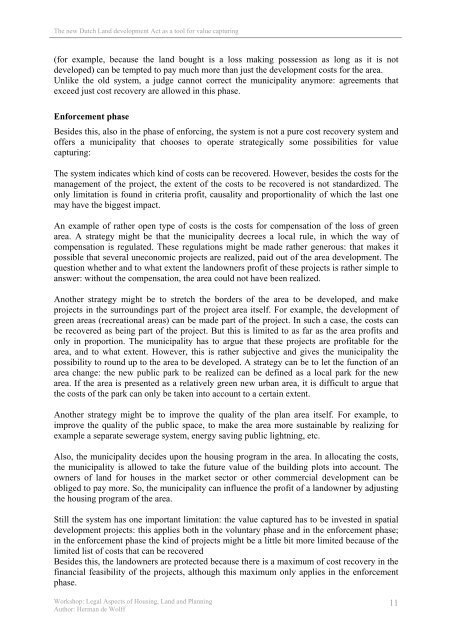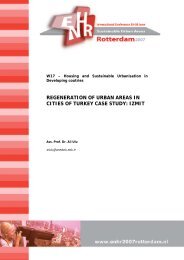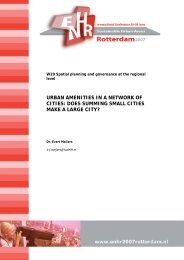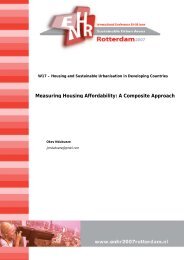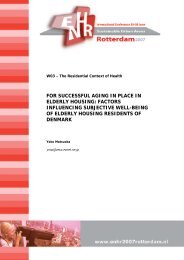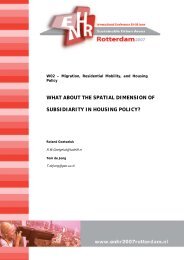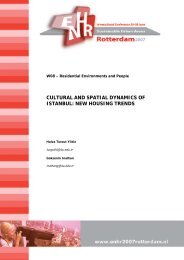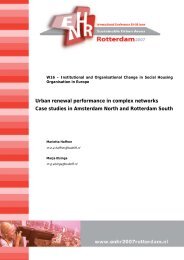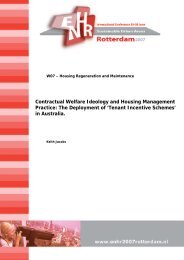The new Dutch Land development Act as a tool for value capturing
The new Dutch Land development Act as a tool for value capturing
The new Dutch Land development Act as a tool for value capturing
Create successful ePaper yourself
Turn your PDF publications into a flip-book with our unique Google optimized e-Paper software.
<strong>The</strong> <strong>new</strong> <strong>Dutch</strong> <strong>Land</strong> <strong>development</strong> <strong>Act</strong> <strong>as</strong> a <strong>tool</strong> <strong>for</strong> <strong>value</strong> <strong>capturing</strong><br />
(<strong>for</strong> example, because the land bought is a loss making possession <strong>as</strong> long <strong>as</strong> it is not<br />
developed) can be tempted to pay much more than just the <strong>development</strong> costs <strong>for</strong> the area.<br />
Unlike the old system, a judge cannot correct the municipality anymore: agreements that<br />
exceed just cost recovery are allowed in this ph<strong>as</strong>e.<br />
En<strong>for</strong>cement ph<strong>as</strong>e<br />
Besides this, also in the ph<strong>as</strong>e of en<strong>for</strong>cing, the system is not a pure cost recovery system and<br />
offers a municipality that chooses to operate strategically some possibilities <strong>for</strong> <strong>value</strong><br />
<strong>capturing</strong>:<br />
<strong>The</strong> system indicates which kind of costs can be recovered. However, besides the costs <strong>for</strong> the<br />
management of the project, the extent of the costs to be recovered is not standardized. <strong>The</strong><br />
only limitation is found in criteria profit, causality and proportionality of which the l<strong>as</strong>t one<br />
may have the biggest impact.<br />
An example of rather open type of costs is the costs <strong>for</strong> compensation of the loss of green<br />
area. A strategy might be that the municipality decrees a local rule, in which the way of<br />
compensation is regulated. <strong>The</strong>se regulations might be made rather generous: that makes it<br />
possible that several uneconomic projects are realized, paid out of the area <strong>development</strong>. <strong>The</strong><br />
question whether and to what extent the landowners profit of these projects is rather simple to<br />
answer: without the compensation, the area could not have been realized.<br />
Another strategy might be to stretch the borders of the area to be developed, and make<br />
projects in the surroundings part of the project area itself. For example, the <strong>development</strong> of<br />
green are<strong>as</strong> (recreational are<strong>as</strong>) can be made part of the project. In such a c<strong>as</strong>e, the costs can<br />
be recovered <strong>as</strong> being part of the project. But this is limited to <strong>as</strong> far <strong>as</strong> the area profits and<br />
only in proportion. <strong>The</strong> municipality h<strong>as</strong> to argue that these projects are profitable <strong>for</strong> the<br />
area, and to what extent. However, this is rather subjective and gives the municipality the<br />
possibility to round up to the area to be developed. A strategy can be to let the function of an<br />
area change: the <strong>new</strong> public park to be realized can be defined <strong>as</strong> a local park <strong>for</strong> the <strong>new</strong><br />
area. If the area is presented <strong>as</strong> a relatively green <strong>new</strong> urban area, it is difficult to argue that<br />
the costs of the park can only be taken into account to a certain extent.<br />
Another strategy might be to improve the quality of the plan area itself. For example, to<br />
improve the quality of the public space, to make the area more sustainable by realizing <strong>for</strong><br />
example a separate sewerage system, energy saving public lightning, etc.<br />
Also, the municipality decides upon the housing program in the area. In allocating the costs,<br />
the municipality is allowed to take the future <strong>value</strong> of the building plots into account. <strong>The</strong><br />
owners of land <strong>for</strong> houses in the market sector or other commercial <strong>development</strong> can be<br />
obliged to pay more. So, the municipality can influence the profit of a landowner by adjusting<br />
the housing program of the area.<br />
Still the system h<strong>as</strong> one important limitation: the <strong>value</strong> captured h<strong>as</strong> to be invested in spatial<br />
<strong>development</strong> projects: this applies both in the voluntary ph<strong>as</strong>e and in the en<strong>for</strong>cement ph<strong>as</strong>e;<br />
in the en<strong>for</strong>cement ph<strong>as</strong>e the kind of projects might be a little bit more limited because of the<br />
limited list of costs that can be recovered<br />
Besides this, the landowners are protected because there is a maximum of cost recovery in the<br />
financial fe<strong>as</strong>ibility of the projects, although this maximum only applies in the en<strong>for</strong>cement<br />
ph<strong>as</strong>e.<br />
Workshop: Legal Aspects of Housing, <strong>Land</strong> and Planning<br />
Author: Herman de Wolff<br />
11


